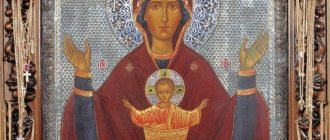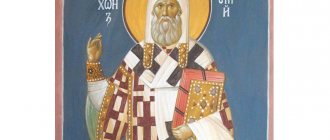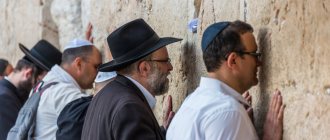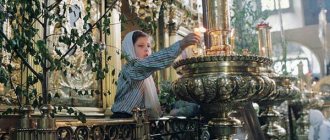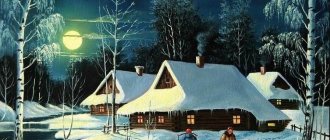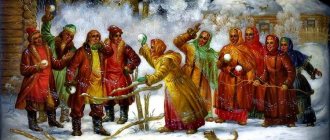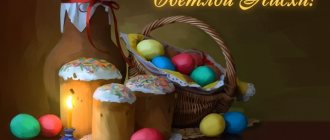THOMAS
In the perception of many people, the Revelation of the Apostle John the Theologian, or the Apocalypse, is the most mysterious biblical book. This is the only text that details how the world will end. The book is filled with a huge number of symbols, the meaning of which humanity has been pondering for more than one millennium.
“Thomas” asked Anton Nebolsin, a professor at PSTGU, who has been studying the text of the Apocalypse for many years, to talk about the ten most famous of them.
Four animals
And in the midst of the throne and around the throne were four living creatures, full of eyes in front and behind. And the first living creature was like a lion, and the second living creature was like a calf, and the third living creature had a face like a man, and the fourth living creature was like a flying eagle. And each of the four animals had six wings around, and inside they were full of eyes; and they have no rest day or night, crying out: Holy, holy, holy is the Lord God Almighty, who was, who is, and who is to come (Rev. 4:6–8).
These four animals are generally understood as the highest orders of angels. Moreover, their description combines the features of the cherubim from the book of the prophet Ezekiel (chapters 1 and 10) and the seraphim from the book of the prophet Isaiah (chapter 6). From the cherubim they have four faces and many eyes, from the seraphim they have six wings, and also the fact that they proclaim to God “holy, holy, holy.” The symbolism of the number “four” (four cardinal directions), combined with faces representing four different living beings, may indicate the fullness of the created world, united in worship of its Creator.
Vulgate. Swiss National Library. Around 820
Chapter 19
Chapter 19.1–10 is a continuation of the story of Babylon. Only now it is no longer the earthly circumstances of the fall of Babylon that are described, but the triumph of heaven over the punishment of the great harlot.
19
.1–2
After this I heard in heaven a loud voice as if of a large people, saying: Hallelujah!
Salvation and glory and honor and strength be to our Lord! For His judgments are true and righteous: because He condemned that great fornicator, who corrupted the earth with her fornication, and exacted the blood of His servants from her hand. After
After John saw the fall of the great Babylon and heard the cry of the inhabitants of the earth about it, he
a triumphant and rejoicing
voice
in heaven .
John does not indicate who exactly this voice belonged to, but only says that it was a loud voice of a seemingly large people
.
Andrew of Caesarea here means by the jubilant choirs of all the inhabitants of heaven - both angelic forces and equal-angelic people. All together, as the numerous people of the heavenly kingdom, they triumph, rejoicing at the fall of Babylon, saying hallelujah
!
In Hebrew it means “praise God.” Hallelujah is the most common biblical cry of praise and praise to God. And the Christian Church in its prayers sends repeated “hallelujah” to God. Hallelujah
!
- the heavens rejoice - salvation and glory, and honor and strength to our Lord!
A more correct translation: “salvation, and glory, and power...” We have already encountered similar praise of the celestials several times in the Apocalypse (4.11; 5.12; 7.10.12; 12.10).
Salvation...
came to the Lord through the fall of Babylon, for this city greatly annoyed Him with its sins.
And now the Lord has been saved from always having to see and endure this. Nothing offends God more than the sins of His creation. But sin is stopped, He is saved from the contemplation of a sinful rebellious creature. Christians were also saved from their terrible persecutor - the great harlot. The faithful were saved from the executions of the devil. And glory... to the Lord
for the trial in which justice triumphed, for the overthrow of the city of sin, for the triumph of the omnipotence of God.
And power
, for from now on the Lord “will abolish all rule and all authority and power.
For He must reign... that God may be all in all” (1 Cor. 15:24–25,28). In the fall of Babylon there will be the highest manifestation of God's power on earth. Thus the inhabitants of heaven were prompted to this wonderful praise, for His judgments are true and righteous
.
Earthly courts often serve lies and untruths. But
the judgments
will be true and righteous . Therefore, man, abandon all lies and untruths and become a servant of truth and righteousness!
The truth and righteousness of God's judgments will be manifested in two ways. Firstly, because He condemned that great fornicator who corrupted the earth with her fornication.
She will not forever exert her harmful influence on the world; the Lord condemned her to eternal destruction.
Sin is stopped. Secondly, He exacted the blood of His servants from her hand.
The hand of a harlot shed the innocent blood of God's servants. The souls of the murdered cried out for retribution (6:10). Retribution came - and the souls of the righteous rejoiced and glorified the Lord for the righteous reward. The heavenly angels perceived the sorrow of the righteous as their own sorrow. How they now rejoice with them about their own liberation. O wonderful rejoicing of heaven! Now in weakness and sorrow. Now with strained and hoarse voices, now dumb and deaf - then they will rejoice along with the angels with the loud voice of as if a numerous people! Now the noise and cries of a numerous people who do not know God drown out the harmonious singing of the faithful - then the singing of the numerous people of the faithful will ring the universe with its angelic beauty.
Rev.19:3 And a second time they said: Hallelujah! And its smoke rose forever and ever.
And they said a second time: Hallelujah!
This, as it were, emphasizes: Amen, Amen - truly so, and sends out a special alleluia to God.
And its smoke rose forever and ever.
This is similar to the prophecy of Isaiah: “And its rivers shall be turned into pitch, and its dust into brimstone, and its land shall be burning pitch: it shall not be quenched day or night; its smoke will rise forever” (Isa. 34:9-10). Ten kings will destroy Babylon and burn it. And the smoke from its ruins will turn into the smoke of the eternal fire of Gehenna torment. Thus, the earthly judgment of Babylon will be final and will mark the beginning of the Last Judgment. This happens even now. If a person, while still alive, completely and consciously turns away from God, blaspheming the Holy Spirit and all grace, then the Lord sometimes allows judgment to take place on earth. And this is the final judgment, marking the beginning of eternal torment for this person. For such, says the Apostle John, one should not pray (1 John 5:16). Here is an example: “On the appointed day, Herod, dressed in royal clothing, sat on a high place and spoke to them; and the people exclaimed: This is the voice of God, and not of man. But suddenly the Angel of the Lord struck him because he did not give glory to God; and he was eaten by worms and died” (Acts 12:21–23). So the torment from these worms passed for Herod into the eternal torment of Gehenna, “where their worm does not die” (Mark 9:46).
The smoke from the conflagration of Babylon, rising forever and ever, also means that the punishments sent to Babylon on earth will never be forgotten. And also that the punishment of Babylon will not be limited to earthly destruction and fire, but will go into the eternal torment of Gehenna fire.
Rev. 19:4 Then the twenty-four elders and the four living creatures fell down and worshiped God who sat on the throne, saying: Amen! Hallelujah!
The doxology of the celestials now includes the 24 elders and four living creatures that we have seen many times before at the throne of God. They confirm the heavenly praise, saying: Amen!
- truly so, and they themselves echo:
hallelujah!
God appears here sitting on a throne
. By this is meant either His special residence in heaven, His special place of glory; or these are the highest angelic powers: thrones, cherubim and seraphim.
To Him, God, sitting on the throne: Amen, Hallelujah!
But even this praise is not enough.
Rev. 19:5 And a voice came out from the throne, saying, Praise ye our God, all ye his servants, and ye that fear him, both small and great.
Not everyone has yet joined in the praise of heaven. Now the voice from the throne
God calls upon
all His servants and those who fear Him
to give praise to God.
No one should be left behind. And small
in virtue and deeds, and
great
church luminaries, teachers, ascetics, martyrs - everyone should glorify God. We can also learn a practical lesson from this. Glorifying God and serving Him is not and should not be exclusively the work of the church hierarchy, monks and ascetics. Everyone must participate in this: small and great. This is the work of every Christian. Each person, according to the gift and calling he has received from God, must glorify God and serve Him with all his heart and with all his soul. Everyone must find their place in the “choir” praising God. Do you praise God? Are you serving Him? Or are you standing indifferently on the sidelines?..
Whose voice is this from the throne
calling to praise God?
This is not the voice of God Himself, for the voice speaks these words: our God
. But this may be the voice of the Lamb-Christ, who once spoke about His ascension “to My God and your God” (John 20:17). Or the voice of the highest angelic powers - thrones, cherubim, seraphim.
And in response to this call, John writes:
Rev. 19:6 And I heard like the voice of a great people, like the sound of many waters, like the voice of mighty thunderings, saying: Hallelujah! for the Lord God Almighty reigns.
Now the glorification of God is heard from the entire assembly of saints. John gives a threefold comparison of the sonority and strength of this voice. He
- as the voice of a large people
,
- like the sound of many waters
,
- like the voice of strong thunder
.
So solemn, majestic and amazing is the singing of all the saints, by which some meant the “waters that are above the heavens” mentioned by the psalmist (Ps. 149:4). And they sing again nothing more than hallelujah
!
This “hallelujah” surpassed the previous ones in beauty and power of execution. This was the highest moment of heavenly triumph. What are the heavens rejoicing about now? That the Lord God Almighty has reigned
!
This reign occurred through the overthrow of Babylon and the destruction of wickedness, as well as through the establishment of a new order of things, through the establishment of a new kingdom throughout the Universe, the kingdom of the Lord God Almighty
.
Now, soul, you often see the triumph of injustice, the forces of darkness and wickedness, you have sorrow while living in the world (John 16:33), but take comfort in the fact that the day will come and the judgments of God will come, evil will be stopped, the Lord will reign! Tremble, however, to do evil yourself, so as not to be subjected to eternal destruction, but strive with all the heavenly powers to sing: Hallelujah!
Next, the praise of the inhabitants of heaven turns into a hymn about the marriage of the Lamb and His wife (vv. 7–9). At the same time, the words of Art. 7–8 still belongs to the council of saints and angels, and the words of v. 9 belong to one angel talking with John.
Rejoicing and triumphant, all the celestials turn to each other:
Rev. 19:7 Let us rejoice and be glad and give glory to Him; For the marriage of the Lamb has come, and His wife has made herself ready.
“Rejoice and be glad, for great is your reward in heaven” (Matthew 5:12), the Lord called upon His followers while still on earth. And the Apostle Peter consoled faithful Christians: “But rejoice as you share in the sufferings of Christ, so that when His glory is revealed you will rejoice and triumph” (1 Pet. 4:13). And now the last moment of world history has come, Babylon has fallen, the manifestation of the glory of God is coming, and therefore the saints call on each other: let us rejoice and be glad and give glory to Him
, that glory which befits Him alone and about which He said: “I will not give My glory to another” (Is. 42:8). Blessed is he who on that day is invited to joy and gladness, and not burst into cries of despair!
And then the reason is indicated that especially prompted the inhabitants of heaven to call everyone to joy and gladness: for the marriage of the Lamb has come, and His wife has prepared herself
. This is about the union of Christ and the Church, which is repeatedly and mysteriously signified in Scripture as the union of the bride and groom, husband and wife. In the same way, the union of the Lord with Israel, the Old Testament Church, was also signified. “For your Creator is your husband; The Lord of Hosts is His name; and your Redeemer is the Holy One of Israel: He will be called God of the whole earth. For as a woman forsaken and grieving in spirit the Lord calls you, and as a woman of youth who was rejected, says your God. I left you for a little time, but I will receive you with great mercy” (Isaiah 54:5-7). The Lord’s attitude towards Israel is depicted in a similar way in the prophet Ezekiel: “And I passed by you and saw you, and behold, it was your time, the time of love; and I stretched out My garments over you, and covered your nakedness; And I swore to you and entered into a covenant with you, says the Lord God, and you became Mine. I washed you with water (a type of baptism - G.F.) and washed away the blood from you and anointed you with oil (a type of anointing with the Holy Spirit - anointing - G.F.). And he put on you a patterned robe, and put morocco sandals on you, and girded you with fine linen (a sign of justification and righteousness - G.F.) ... And he put a beautiful crown on your head” (Ezek. 16:8-12). This is how the Lord speaks about his betrothal to the people through the prophet Hosea: “And I will betroth you to Me forever, and I will betroth you to Me in righteousness and judgment, in kindness and mercy. And I will betroth you to Me in fidelity, and you will know the Lord” (Hosea 2:19-20). The New Testament especially transfers this relationship to the union of Christ with His redeemed Church. Christ called Himself the Bridegroom when He was on earth. So, when asked why His disciples did not fast, He answered: “Can the sons of the bridal chamber mourn while the bridegroom is with them? But the days will come when the bridegroom is taken away from them, and then they will fast” (Matthew 9:15). And if Christ called His disciples “sons of the bridal chamber,” then John the Baptist was the friend of the Bridegroom at this marriage. This is what John the Baptist himself said about Christ, the Church and himself: “he who has a bride is a groom; and the groom’s friend, standing and listening to him, rejoices with joy, hearing the groom’s voice. This is my joy fulfilled” (John 3:29). And again, the union of the soul and the Church in general with Christ is compared with the union of the bride and groom, husband and wife. So the Apostle Paul says to the Corinthians: “I have betrothed you to one husband, that I may present you to Christ as a pure virgin” (2 Cor. 11:2). And in another place Paul says: “Husbands, love your wives, just as Christ loved the Church and gave Himself for her” and “the husband is the head of the wife, just as Christ is the head of the Church.” “We are members of His body, of His flesh and of His bones. Therefore a man will leave his father and mother and be united to his wife, and the two will become one flesh. This mystery is great; I speak in relation to Christ and to the Church” (Eph. 5:25,23,30–32). When Adam was sleeping, his wife was taken from his side, and therefore man leaves both his father and mother in order to be reunited with her again.
When Christ “fell asleep” on the Cross in the sleep of death, blood and water flowed from His pierced rib. And so, in the blessed water of baptism and the blood of communion, the Church is born, the Christian soul is born for eternal life. Thus, the Church, His beloved bride, was taken from the side of Christ. Therefore, in His second glorious coming He will leave His Heavenly Father and the Most Pure Mother, the Ever-Virgin Mary, and will come as a groom to the bride for His Church. “Then the kingdom will be like ten virgins, who took their lamps and went out to meet the bridegroom... the bridegroom came, and those who were ready went in with him to the wedding feast” (Matthew 25:1,10). “And you will be like people waiting for their master to return from marriage, so that when he comes and knocks, you may immediately open the door to him” (Luke 12:36). Just as the Church sings during Holy Week: “Behold, the Bridegroom comes at midnight, and blessed is the servant, he will be found vigilant; if he is not worthy again, he will be despondent. Take care, my soul, not to be burdened with sleep, lest you be given over to death, and be shut out of the Kingdom; but arise, calling: Holy, holy, holy art thou, O God, through the Theotokos have mercy on us” (troparion of Matins). And if the coming of Christ is compared with the coming of the groom for the bride, then the very union and eternal triumph of Christ with the Church, God with humanity is called the wedding feast or wedding supper of the Lamb (Matthew 22:1-14). This is the ineffable, mysterious and complete union of man with God. The song of the celestials is about this, for the marriage of the Lamb has come
, the cherished and longed-for hour has come.
But one cannot enter the bridal chamber without the wedding garment (Matthew 22:11–13), and therefore His wife prepared herself
. For many centuries, the Christian Church, the wife of the Lamb, prepared itself for the meeting with the heavenly Bridegroom. How did she prepare herself? This preparation consisted of developing, increasingly deepening and crystallizing church teaching, cutting off all kinds of harmful heresies. In creating and performing a wondrous and unique worship service. In the countless exploits of holy ascetics, monks and martyrs. In witnessing to the world Divine truth, the manifestation of heavenly uncreated beauty and the outpouring of peace, goodness and love to people. This preparation of the Church consisted in the grace-filled sanctification of each of her children and bringing him to Christ, to heaven. The final preparations of the Church will take place during the days of the terrible persecution of the Antichrist. Coming out of this all-purifying crucible, the Church will be finally prepared. All preparations for the marriage are completed, the lamps are lit, it is almost midnight, all that remains is for the groom to enter the bridal chamber.
Soon a heavenly marriage. Soul, have you prepared yourself?
Rev. 19:8 And it was given to her that she should be clothed in fine linen, clean and bright; The fine linen is the righteousness of the saints.
This is the wedding garment of the wife-Church, in which she has the right to enter the heavenly bridal chamber. How very different this clothing is from the clothing of the great harlot. Everything there was luxurious, royal: purple, purple, gold, precious stones, pearls. Here there is pure silk, signifying the holiness of the wife. Andrew of Caesarea explains the meaning of fine linen
as lordship in virtues, subtlety in understanding and height in reflection and contemplation.
The fine linen is pure
because the Church has cleansed its children from all sins and vices.
The fact that it is bright means that she enlightened them with the uncreated light and made them the light of the world (Matthew 5:14). She enlightened them with heavenly grace, as if she wove their being from subtle light. No one can put on such clothes himself. Independent attempts to cleanse oneself of sins and partake of unearthly light are the fruit of spiritual delusion and lead to purity and light in one’s own clouded eyes, as well as in front of those who are mistaken and wandering in the darkness. In the eyes of God and the saints, this is uncleanness and darkness. Such are false religions and irreligion, forcing a person to achieve for himself what he cannot achieve and what can only be given to him, as it is said here that it was given to her to be clothed in fine linen
.
She did not achieve this herself, but it was given to her
from God, as a gift from God.
And further it is explained: fine linen is the righteousness of the saints.
The saints are clothed with righteousness, that which will justify them before God.
What can justify us, fallen creatures, before the Creator? First, no one’s own efforts in themselves, for “pardon does not depend on the one who wills, nor on the one who runs, but on God who shows mercy” (Rom. 9:16). God, who is merciful, out of His ineffable love for mankind, having become incarnate, shed His most pure Blood and with it justifies us. And now in the sacraments a person “is justified freely by His grace, the redemption that is in Christ Jesus” (Rom. 3:24), and is clothed in clean and bright clothing, which is the righteousness of the saints
. Only this clothing, received in the sacraments, can justify us before God, for in the sacraments we put on Christ Himself, Who is our justification. See Gal. 3:27 (baptism), James. 5:14 (blessing of oil), John. 6:56 (communion), Eph. 5:31–32 (wedding). But these clothes must be kept clean and bright, otherwise they will not help. And this is achieved through faith, repentance, spiritual deeds, prayer and good deeds. It can be compared like this. He gives us different clothes (Christ in the sacraments), but we have to wear them ourselves (our virtuous life in Christ).
This ends the heavenly praise heard by John. Then one angel speaks to him.
Rev.19:9 And the angel said to me, Write: Blessed are those who are called to the marriage supper of the Lamb. And he said to me: these are the true words of God.
There is no word “Angel” in the original, but from a comparison with Art. 10 indeed, the speaker here can be understood to be an angel. Emphasizing the great importance of his words, the angel commands not only to listen to what he said, but also to write it down. Write: Blessed are those who are invited to the marriage supper of the Lamb.
We have already seen what
the wedding supper of the Lamb
.
To be a member of it is the highest bliss. But it will only exist in eternity after the Last Judgment. Only when the last one to be saved enters the saving ship of the Church and evil is destroyed, only then will the indescribable union of the creature with the Creator be possible at the wedding supper of the Lamb (Acts 2:47). However, even without having yet tasted the bliss of that heavenly marriage, even now on earth those invited to the wedding supper are blessed
.
For those invited
to the heavenly feast do not expect the meaningless disappearance of human life into nowhere, just as unbelievers do not despair from the horrors of eternal death. Christ said about these that “he who believes in Him who sent Me... has passed from death into life” (John 5:24). Such people are blessed simply because they are called to the Divine Supper in heaven, and by this they are comforted and strengthened in earthly sorrows.
These words of the angel echo the words of the heavenly voice in 14:13: “Blessed are the dead who die in the Lord from now on.” Yes, truly blessed is he who has already prepared for himself a place in heaven on earth!
Andrew of Caesarea explains the various names of the future century in this way. It is called the "Kingdom of Heaven" because of its glory and integrity; “paradise” - due to the abundance of the table of pleasures; “Abraham’s bosom” - according to the repose of the deceased in it; “chamber and marriage” - according to the endless joy and true ineffable union of God with His servants.
To strengthen the impression of his words about those called to the supper of the Lamb and to confirm their truth and Divine origin, the angel said to John: these are the true words of God
. And “he who calls you is faithful, who will do these things” (1 Thess. 5:24).
Rev.19:10 I fell at his feet to worship him; but he said to me: see that you do not do this; I am a fellow servant with you and with your brothers who have the testimony of Jesus; Worship God; for the testimony of Jesus is the spirit of prophecy.
Such a scene ends the vision of heavenly triumph, rejoicing over the fall of Babylon. John worships the angel, but he does not accept his worship and tells him to worship God. This is one of the main passages of Scripture cited by sectarians against the Orthodox dogma of the veneration and worship of angels. At the same time, they say that the Apostle John wanted to worship the angel, but he forbade him to do this, pointing out that worship should be performed only to God. “Worship the Lord your God and serve Him alone” (Matthew 4:10). The Orthodox, they say, worship not only God, but also angels, and perform services for them, thereby violating God’s law.
That this interpretation of the sectarians is incorrect is easily seen from the following considerations.
The revelation was received by John on the island of Patmos in 95 or 96. Or, even if we assume the version of the early writing of the Apocalypse, then in 67. At the very least, no one can doubt that by the time the Revelation was received, Churches had already been planted throughout Asia Minor, in Ephesus, Smyrna, and Pergamum (chap. 1-3). The apostles had already spread the news of Christ to many countries. So is it really possible that after they had declared the entire Roman Empire, they still did not know the basic truth of who should be worshiped and who should not?! What did they preach to the pagans about then, if they were still confused about who could be worshiped and who could not?! Is it really possible that the Jerusalem Church, which was still ruled by all twelve apostles and in which there were often apparitions of angels (Acts 1:10; 5:19; 8:39; 12:6-11), did not know what to do in such cases and worshiped angels in her “ignorance”, when this should not have been done? Did the eleven apostles and the authors of the New Testament holy books all die without knowing exactly who could and could not be worshiped, and only at the end of their lives this was reported to the Apostle John?! It turns out that the teachers of true worship did not know who to worship! The sectarian interpretation leads to such an absurd conclusion. In addition, it can be noted that the issue of permissible and impermissible worship was generally resolved in the Old Testament. The Jews knew this very well. Only the pagans did not know this.
If it is finally explained to the Apostle John that one cannot bow to angels, but only to God, then why does he make the same mistake after a short time? (22.8–9). After all, John really couldn’t have forgotten such a truth so quickly? After all, all this does not happen before the day of Pentecost, but when he had long been a pillar of the Church (Gal. 2:9).
How then can we explain everything that happened to the secret viewer? The explanation lies, in fact, in the words of the angel himself: I am a fellow servant with you and your brothers
.
The angel puts himself on a par with the apostle and all Christians (brothers) in general. Why did he need to explain this to John? Is it because he mistook him not for a fellow servant, but for the Lord Christ Himself? Christ had already appeared to him in various forms: sometimes in the form of the Son of Man (1:13; 14:14), sometimes in the form of a Lamb (5:6). And in 20.1 we will actually see Christ appearing in the form of an angel. The prophet Malachi calls Christ the Angel of the Covenant (Malachi 3:1). Thus, John, struck by the vision of heavenly triumph, mistook the appearing angel for the Angel of the Covenant Himself - Jesus Christ and fell at his feet to worship him
as God and ruler.
But he said to me: see, don’t do this;
I am a fellow servant with you and with your brothers who have the testimony of Jesus; Worship God. Divine worship is due to God alone.
The angel seems to say to John: you were amazed by the testimony with which I appeared to you, but the testimony of Jesus is the spirit of prophecy
.
And you, John, and your brothers, and I, an angel, - we, who have the testimony of Jesus
and proclaim to the world the mysteries of the future, need to know that we do this not from our own knowledge and reason, but through the spirit of prophecy, which is from God, but therefore
worship
. This is how we see the humility of the bright angels, who do not appropriate to themselves, like demons, Divine glory.
The same fact that angels as angels are due honor and worship is repeatedly testified by Scripture itself: Josh. 5:14–15; Court. 13:20; 1 Par. 21:16; Number 22:31; Comrade 12:15–16; Dan. 8:16–18. The examples of the prophet Balaam, Joshua, Manoah and his wife (Samson’s parents), Tobit and Tobiah, David and his elders, the prophet Daniel show that angels are worshiped as angels, and they accept it. We also see in Scripture that saints are to be worshiped as saints. Divine worship belongs only to God, and when it was shown to angels or saints, they rejected it from themselves.
The fact that, following the example of the Old Testament Church, the first Christians revered angels can be judged, for example, from this ancient testimony of St. Justin the Philosopher (2nd century): “We honor both the Father of Truth and the Son who came from Him... Together with the army of others good angels who follow and resemble Him, and we openly teach this to everyone who wants to learn as we ourselves were taught.” Saint Justin expresses not just his private opinion, but the direct disciples of the apostles testified to worship: Saints Polycarp, Clement of Rome, Ignatius the God-Bearer (Apology 1, paragraph 6). And the Seventh Ecumenical Council (787) clearly taught: “We also enthusiastically accept the Lord’s and the apostolic and prophetic sayings, by which we are taught to honor and magnify firstly the actual and truly Mother of God, the highest of all the heavenly powers, as well as the holy angelic powers, blessed and all-praised apostles and prophets, glorious saints and God-bearing teachers and all reverend men, and ask for their intercession, since they can bring us closer to the King of all - God, of course, if we keep His commandments and try to live virtuously.”
Book sealed with seven seals
And I saw in the right hand of Him who sat on the throne, a book written within and without, sealed with seven seals (Rev. 5:1)
This image is one of the most famous. The expression “a secret sealed with seven seals” has become firmly established in everyday language, and even those who have never read the Revelation of John the Theologian know it. The Lamb-Christ, being the only one in the whole world who is worthy and able to do this, takes the book from the hand of Him who sits on the throne, that is, God the Father, and opens the seals from it. By accepting the book, the Lamb causes rejoicing throughout the Universe.
During the almost two-thousand-year history of interpretation of the Apocalypse, various interpretations of this image have been proposed. Two main ones can be considered: the book is understood either as an image of the Divine plan for the world, or as Holy Scripture. Both interpretations go back to ancient church tradition.
The understanding of the sealed book in the sense of the Bible is presented, in particular, by Victorinus of Petavisky. The essence of this interpretation is that Christ is the only One who can remove the seals from Divine Scripture, that is, reveal its true meaning, while without turning to Him the meaning of the sacred books remains hidden and unknown. Understanding the book as God's plan for the world emphasizes that without the sacrificial service of Christ this plan cannot be realized. The interpretation of Andrew of Caesarea combines both of these views. According to him, “the book means the wise memory of God, in which everything is written, as the divine David speaks about this (this), but one can also understand the depth of Divine destinies,” and also “by book one can also understand the prophecies about which Christ spoke, that they were partially fulfilled in the Gospel (Luke 24:44 ), but will be completely fulfilled in the last days.”
Lamb opening the book with seven seals. Miniature from the Apocalypse. XIII century (Bodl. Douce. 180. Fol. 21)
Chapter 6
Rev. 6:12 And when He opened the sixth seal, I looked, and behold, there was a great earthquake, and the sun became dark as sackcloth, and the moon became like blood.
And when He opened the sixth seal, I looked
- secret after secret is revealed to John. Everything further described under the opening of the sixth seal can be understood literally as changes that will occur in the natural order of things. On the other hand, this is a figurative description of the religious and moral changes of recent times. It also applies to the ruin that occurred under Vespasian and Titus, but more so to the time of the Antichrist.
And then a great earthquake occurred
, what would that mean? – most likely a concussion in general, changing the order of things. Everything that follows is presented as a consequence of this shock (“great coward” in Slavic). The earthquake itself is most likely indicated by the end of verse 14 (the mountains and islands moved from their places). The result of the shaking is changes throughout the world: in the sun, moon, stars. The prophet Haggai speaks about this change of affairs, about the great shaking: “For thus says the Lord of hosts: Once again, and it will be soon, I will shake the heavens and the earth, the sea and the dry land, and I will shake all nations” (Hag. 2:6– 7). Christ “has now made this promise: once again I will shake not only the earth, but also the heavens. The words “once again” signify the change of what is shaken as if it were created” (Heb. 12:26–27).
The following describes the events of this great end-time shaking. And the sun became dark as a hair shirt.
Just as the prophet Isaiah said: “I clothe the heavens with darkness, and make sackcloth for their covering” (Is. 50:3).
And the moon became like blood.
So the prophet Joel says: “The sun and the moon will darken and the stars will lose their shine. And the Lord will thunder... the heavens and the earth will tremble” (Joel 3:15–16). Christ himself spoke about this: “The sun will be darkened, and the moon will not give its light, and the stars will fall from the sky, and the powers of the heavens will be shaken” (Matthew 24:29). It is possible that there will literally be terrible cosmic catastrophes; and, on the other hand, as Blessed Cyril of Jerusalem explains, the black color of the sun and the dark bloody color of the moon indicate the spiritual darkness of those who will suffer the wrath of God. Then all the lights will go out, and the great ones of this world will darken. And now, during a solar eclipse, the sun is darkened, as if clad in hair shirt. And during a lunar eclipse, the moon turns red. So with the apocalyptic red color of the moon in the last time, when everything darkens, collapses and changes, everything that people worshiped will become gloomy and reveal its ominous color of blood.
The light of the sun and moon is hidden for some, who will forever plunge into eternal darkness. It is also hidden for others, for they will already have to live in a different radiance - the direct radiance of the light of God and the Lamb.
Rev. 6:13 And the stars of heaven fell to the earth, as a fig tree, shaken by a strong wind, drops its unripe figs.
This is how meteor showers are sometimes observed now. Then, perhaps, great catastrophes will occur in the stellar worlds. In the Old Testament we read how the horn of an enraged goat “exalted itself to the host of heaven, and cast down part of that host and the stars to the earth, and trampled them underfoot” (Dan. 8:10). “This vision refers to the end of the time” (Dan. 8:17). So the Israelites were the same stars and the army of heaven, for they fulfilled the will of Heaven. But they were overthrown. The same thing happened during the ruin of Vespasian and Titus. The falling of the stars of heaven to the earth is also an indication of the deception of believers (the fall of the heavenly ones to the earth), for Satan will do everything possible “to deceive, if possible, even the elect” (Matthew 24:24).
The Church is a fig tree, shaken by the strong wind of persecution, dropping its unripe figs, not yet developed in the heat of temptation and not sweetened by grace. Those who are unconfirmed and insincere in the faith fall away. And on the other hand, like unripe figs, then all earthly authorities will fall, these movie and football stars, political luminaries and helmsmen of states. They think that they are stars shining in the sky for the world, but they are just unripe figs that are torn down by a strong wind.
Rev.6:14 And the heaven was hidden, rolled up like a scroll; and every mountain and island moved from their places.
And the sky disappeared, curled up like a scroll.
Isaiah describes something similar: “The whole heavenly army (stars - G.F.) will decay; and the heavens will be rolled up like a book scroll; and all their army shall fall as a leaf falls from the vine, and as a withered leaf from the fig tree” (Isa. 34:4). The mysterious meaning of this vision. On the one hand, this is a continuation of the description of space disasters. Great changes in the stellar worlds, the sun and the moon continue with atmospheric catastrophes. It will not disappear, but after the darkening of the sun and moon it will disappear from the eyes of people, will be hidden from them in darkness and will be useless to them. On the other hand, this shows that the sky is not subject to decay and destruction on the last day, but, as it were, to some kind of twisting and transformation into something better (20.11; 21.1). The old sky fled - it rolled up like a scroll, and a new one appeared. Saint Irenaeus of Lyons writes in his fifth accusatory word: “Neither the essence nor the being of the creation will perish or be destroyed (for he who created it is true and strong).” “But the image of this world is passing away” (1 Cor. 7:31), in which the crime was committed.
The Jews used scrolls instead of books, the rolling of which did not mean their destruction, but the concealment of what was written. John sees the scroll sky. This means that the heavens will not disappear, but, like a person, will pass into a new state. “In the beginning, O Lord, You founded the earth and the heavens—the work of Your hands; they will perish, but You remain; and they will all wear out like a garment, and you will fold them up like a garment, and they will be changed” (Heb. 1:10-12). The coming of the Lord is approaching, and the sky itself, curled up like a scroll, turns away from the earth, mired and drowned in sins.
The sky disappeared silently and unexpectedly, curled up like a scroll, just as the coming of Christ to the Judgment will be unexpected. The sky silently looked at all the events of human history, recording everything it saw under the sun. But then the story ended, and, like a read book, the sky rolled back into a scroll.
By heaven we also mean angels, who, seeing the abyss of iniquities, sins and sufferings of the last time, will no longer be able to look and will turn away their faces in sadness.
And every mountain and island moved from their places.
There will be great earthquakes then, and maybe volcanoes will come to life. The Lord Himself warned about this that there would be earthquakes in places” (Matthew 24:7). To awaken us from our spiritual sleep and keep us awake for the coming of Christ, God causes the very earth to shake. But isn’t it because of our iniquities that the earth is shaking?!
Under the mountains
one can also understand kings and rulers, and by
islands
their peoples, and one can also understand shepherds with their churches. Everything will shake and move from its usual places.
Rev. 6:15 And the kings of the earth, and the great men, and the rich, and the captains of thousands, and the mighty men, and every slave, and every free man, hid themselves in caves and in the clefts of the mountains.
All these disasters struck - the kings of the earth, and the nobles, and the rich, and the captains of thousands, and the mighty
(here we mean strong in art, and not in physical strength - G.F.),
and every slave and every free man hid in caves and in the gorges of the mountains.
All earthly inhabitants of all classes will be horrified by what is happening. From the enumeration of classes we also see that the organization and structure of society will not fundamentally change until the end of the world. Centuries and millennia pass, the forms of human society change, but its unjust and sinful essence remains unchanged. A society infected with the leprosy of sin cannot heal on its own. Neither reforms, nor revolutions, nor science will help here. Christ said: “My kingdom is not of this world” (John 18:36). And where there is no Christ, there is no truth and justice. Therefore, earthly kingdoms and societies are doomed to eternal injustice until the terrible day of Judgment puts an end to this. Therefore, the Church does not fight for a just society and human rights, but calls people to repentance. He calls them to live in another world in this world. But this call is drowned in worldly noise, only society is plunged into an ever-increasing abyss of lawlessness. But the day will come when, in extreme despair, all classes, hiding in the caves and gorges of the mountains (it will become impossible to feel sick in the cities), will begin to cry out.
Rev. 6:16 And they say to the mountains and the stones, Fall on us, and hide us from the face of Him who sits on the throne, and from the wrath of the Lamb.
Today people don’t want to see all this, they don’t want to admit it. They deny everything indiscriminately and live as in the days of Noah. They pursue pleasures without anticipating a terrible catastrophe. As residents of Sodom, all these warnings are funny to them (Gen. 19:14), and clouds are already gathering, ready to rain down fire and brimstone. Then everyone will cry out. But the time for repentance will end. And those who do not want to now call on God, angels, saints, will then call on the dead elements, mountains and stones. And they will not cry to the Almighty for salvation, but so that at least the dead stones, having covered them, would hide the formidable face of God the Father sitting on the throne and turn away the wrath of the Lamb-Christ. Today is a time of repentance. Today Christ lovingly stretches out His pierced hands to everyone. Then the favorable summer will end (Jer. 8:20), the harvest has passed, and we are not saved - only the wrath of the Lamb remains.
Rev. 6:17 For the great day of His wrath has come, and who can stand?
The Last Judgment is coming. The wrath of God is poured out. Who can resist? Nobody.
Lamb
And I looked, and behold, in the midst of the throne and the four living creatures, and in the midst of the elders, stood a Lamb as if slain, having seven horns and seven eyes, which are the seven spirits of God sent out into all the earth (Rev. 5:6)
The Lamb is the main image of Christ Himself in the Apocalypse (other images of Christ: like the Son of man (chapters 1 and 14) and the Rider on a white horse (chapter 19)), permeating the entire book, starting from the fifth chapter. The general meaning of this image is completely obvious and does not cause controversy: we are talking about the sacrificial service of the Savior, about His death, which atoned for the sins of the whole world (see Rev. 5:9).
Related to this is the repeated emphasis on the significance of the shed blood of the Lamb (Rev 5 :9; 7:14 ; 12:11 ). Different opinions are expressed only about the origins of the very image of the Lamb. In addition to the general understanding of “lamb” in the sense of a sacrificial animal to be slaughtered, they point to the Passover lamb from the book of Exodus (chapter 12), whose blood, being applied to the doorposts, saved the Jews from death during the tenth plague of Egypt (in the Gospel of John the Passover lamb is directly compared with the crucified Christ - John 19:36 ), as well as in comparison with the lamb of the Servant of the Lord, innocently suffering and bearing the sins of humanity (an image clearly attributed in the Christian tradition to Jesus) from the book of the prophet Isaiah (Isaiah 53 :7).
Lamb of God; Italy. Ravenna; VI century; location: Italy. Ravenna. Basilica of San Vitale
Pale Rider
The author of Revelation calls the last rider, galloping on a pale horse, by name. This is Death itself. She destroys people in every possible way. Hell follows this character. Interestingly, the “pale” color of a horse in some translations from ancient Greek sounds like a pale green, reminiscent of the color of the rotting skin of a corpse.
Modern pastors of different churches interpret the pictures depicted in Revelation adjusted to the events of today. In their opinion, a pale green horse symbolizes Islam, a red horse symbolizes communism, and a black horse symbolizes capitalism. The crowned rider on the white stallion is the Christian faith, which must ultimately win. This point of view is shared, for example, by the pastor of the Church of the End of Times, Irwin Baxter.
Mormons interpret the successive appearance of the horsemen of the Apocalypse as 4 consecutive periods. The white horse is a symbol of the era of goodness and righteousness (4th-3rd millennium BC). Red - times of sin, wars and the wrath of God, which appeared on earth in the form of the Flood (3-2 millennium BC).
Voronoi - the era of Abraham, as well as persecution, famine and wanderings of the Jewish people (2-1 millennium BC). The pale horse symbolizes the last era, which continues to this day and will end with the end of the world (“hell” for all the lost).
Four Horsemen
I looked, and behold, a white horse, and a rider on it had a bow, and a crown was given to him; and he came out victorious and to overcome (Rev 6 :2). And another horse came out, a red one; and to him that sat on it was given power to take peace from the earth, and that they should kill one another; and he was given a great sword (Rev 6 :4). I looked, and behold, a black horse, and its rider had a measure in his hand ( Rev 6 :5). And I looked, and behold, a pale horse, and its rider, whose name was “death”; and hell followed him; and authority was given to him over the fourth part of the earth to kill with the sword, and with famine, and with pestilence, and with the beasts of the earth (Rev 6 :8).
Following the opening of the first four seals by the Lamb from the sealed book, four horsemen successively appear before us: on a white, fiery red, raven, that is, black, and “pale” horse. The last three obviously have negative symbolism, pointing to disasters such as war, famine and pestilence. Interestingly, the original Greek text says the color of the fourth horse is “green.” As a rule, this color is understood metaphorically, as an indication of the unhealthy complexion of a terminally ill person. Hence the traditional translation “pale”.
The first horseman depicted in the Bamberg Apocalypse (1000–1020)
As for the first horseman, understanding this image is much more complicated. The white color of the horse and the characterization of the one sitting on it as “conquering” indicate that this rider is the bearer of salvation. This could be Christ Himself or the image of the grace-filled power of the Church saving a person. This was the dominant interpretation in the patristic era: the first horseman was understood either as the image of Christ Himself (Irenaeus of Lyons), or as the image of the triumphant gospel sermon (Andrew of Caesarea).
However, most modern biblical scholars interpret the image of the four horsemen as a negative, evil force. At the same time, some scientists suggest that the first horseman symbolizes the Antichrist, and the white color of his horse and the victorious appearance of the rider can be interpreted as an indication of the Antichrist’s disguise as Christ.
This perception of the four horsemen is reflected in Durer's famous engraving.
Black horseman
John says about the third horseman that he holds a “measure” in his hand and sits on a black horse (Rev. 6:5). Next, a certain voice sounds, setting a price for wheat and barley, but not allowing the wine and oil to be touched (Rev. 6:6). In John's time, this "measure" was used to weigh bulk products. Traders used it.
The fact that such a measure is held in the hands of the third horseman is a symbol of Hunger, both literally and figuratively. Simple food - wheat, barley - in the last days on Earth will become much more expensive or will be in short supply due to droughts. Wine and oil, which are used during Christian services, will remain untouched. This is an allusion to the salvation of people who survive on spiritual food.
The black color of the horse is easily explained from the point of view of the historical context. It symbolizes the color of grapes, which were actively cultivated during the reign of Domitian (81-96). The Romans made a lot of wine from it, indulging the drunkenness of the ruling class. At the same time, the land where grain crops were cultivated became less and less, and this threatened the population with famine.
Two witnesses
And I will give to My two witnesses, and they shall prophesy a thousand two hundred and sixty days, clothed in sackcloth (Rev. 11:3).
The interpretation of the image of the two witnesses among modern biblical scholars is very different from how they were understood by ancient authors. Most early Christian interpreters connected the plot of the two witnesses with the final segment of human history. The two witnesses were understood as two specific righteous men of Old Testament antiquity who appeared for the final testimony of Christ before the world.
Saint Andrew of Caesarea saw in the image of two witnesses an indication of two Old Testament righteous men - Enoch and the prophet Elijah. In modern biblical studies, a different perception prevails, within the framework of which the story of the two witnesses is thought of as a symbolic image of the entire history of the Church - from the era of the apostles to the end of the world.
Parable of the Two Witnesses. Miniatures from the Apocalypse. Beginning XIV century (Cantabr. Corp. Chirst. 20. Fol. 25v)
Woman Clothed with the Sun
And a great sign appeared in heaven: a woman clothed with the sun; under her feet is the moon, and on her head is a crown of twelve stars. She was with child, and cried out from the pains and pangs of birth (Rev. 12:1–2).
From ancient times to the present day, a woman clothed with the sun has been interpreted as an image of the Church. This understanding has deep biblical roots. In the prophetic books of the Old Testament, the relationship between the God of Israel and His people was presented as marital, hence the numerous images of Israel as a wife. This tradition continues in the New Testament writings with the only difference that Christ appears in the role of the Bridegroom or Husband (Matthew 9 :14-15; 25 :1-13; John 3:29 ; Eph 5 :22-33; 2 Cor 11 :2 ; Rev 19 :7–9; 21 :2, 9).
The differences between the ancient and modern understanding of the symbol of the wife clothed with the sun concern the interpretation of the image of her son. If for the Hieromartyr Methodius of Olympus and Saint Andrew of Caesarea the son is a generalized image of a Christian born with grace by the Church, then for most modern biblical scholars he symbolizes Christ, incarnate in the bosom of the Old Testament people of God.
Vision of the ap. John the Theologian "woman clothed with the sun." Miniature from the Apocalypse. XIII century (Bodl. Douce. 180. Fol.)
The Dragon
And another sign appeared in heaven: behold, a great red dragon, with seven heads and ten horns, and on his heads seven diadems. His tail carried away a third of the stars from the sky and threw them to the ground (Rev. 12:3–4).
The interpretation of this image is already given in the Apocalypse itself. According to the text, this is the ancient serpent called the devil and Satan (Rev 12 :9). It is important that he acts as the original enemy of the Church, mobilizing his minions from among humanity, represented in the form of two animals, to fight it.
Vision of the Apostle John the Theologian of the “woman clothed with the sun.” Miniature from the Apocalypse. XIII century (Bodl. Douce. 180. Fol.).
Generally Accepted Treatises
According to the New Testament, the horsemen are called:
Conqueror - a warrior who rides on a white horse and holds a combat bow;
War is the next horseman in order, whose features are bloody robes and the presence of a sword;
Conqueror
War
Hunger - depicted as a very fat rider riding a thin horse. Instead of a weapon, he holds scales;
Death is a character on a pale horse, depicted as a rider who uses a scythe as a weapon.
Hunger
Death
Modern religious scholars view Revelations in terms of possible prophecies dating back to the beginning of the Christian faith. And the horsemen act as conquerors - the Parthian army. As evidence of this, they cite the bow that the first of them carries in his hands. After all, it was the Parthians who were famous for their excellent archers, who made up the majority of their troops. In addition, the Parthians most often used white horses in the army. Some experts even call the prototype of the Conqueror - the Parthian step of Vologeses, who fought with Rome and won many battles in the first century AD.
Historical associations also led to the formation of the image of the Famine. At the end of the 1st century AD, Emperor Domitian wanted to limit the spread of vineyards by sowing free land with cereals. This caused a violent reaction from the people, which forced the ruler to abandon the implementation of his plans. Famine in this context appears as a character that destroys grain supplies without harming the wine and oil.
The red horseman, according to researchers, personifies the interstate and civil wars that took place during the times described in the book of John the Evangelist.
Two animals
And I stood on the sand of the sea, and I saw a beast come up out of the sea, having seven heads and ten horns: on his horns were ten crowns, and on his heads were names of blasphemy (Rev. 13:1).
And I saw another beast coming out of the earth; he had two horns like a lamb and spoke like a dragon (Rev. 13:11).
In the 13th chapter of the Apocalypse two beasts are presented: one coming out of the sea, the other from the earth. Their activities are described in detail, so understanding these images in the most general sense is not controversial. The two beasts are representatives of humanity, receiving their powers from the dragon-Satan and serving him. All their activities are aimed at fighting God.
A beast emerging from the sea.
The first beast is the embodiment of pride, blasphemy and violence. The second performs various kinds of wonders and signs; his main task is to seduce people. And, according to the text, the second beast successfully copes with this task, so that the people, shocked by its miracles, bowed to the first beast. It is characteristic that in the further narration of the Apocalypse the beast that came out of the earth is called a false prophet (Rev. 16:13; 19:20; 20:10).
This pair of images is interpreted in two ways, due to their extreme complexity and ambiguity. So, for example, in two animals they see both images of specific carriers of evil, and images of godless states or social institutions. Some interpreters saw in the image of the first beast a symbol of the Roman Empire, which subjected Christians to persecution, and in the image of the second - a symbol of the institution of priesthood of the imperial cult.
Beast from the earth.
The Great Whore of Babylon and the Bride and Wife of the Lamb, New Jerusalem
And one of the seven angels who had the seven bowls came and spoke to me and said to me: Come, I will show you the judgment of the great harlot who sits on many waters; The kings of the earth committed fornication with her, and those who dwell on the earth were drunk with the wine of her fornication. And he led me in spirit into the desert; and I saw a woman sitting on a scarlet beast, full of names of blasphemy, having seven heads and ten horns (Rev. 17:1–3).
And one of the seven angels came to me, who had the seven bowls filled with the seven last plagues, and said to me: Go, I will show you a wife, the bride of the Lamb. And he carried me away in the spirit to a great and high mountain, and showed me the great city, holy Jerusalem, which came down out of heaven from God (Rev. 21:9–10).
These two undoubtedly grandiose images are opposed to each other. The New Jerusalem is a symbol of the perfect unity of Christians with God in the next century, when nothing sinful or evil can disrupt this unity. The description of the city is dominated by the symbolism of the number 12 (It has a large and high wall, has twelve gates and twelve Angels on them; on the gates are written the names of the twelve tribes of the sons of Israel (Rev 21:12 ), traditionally associated with the image of the Church (12 tribes of Israel, 12 apostles).
On the contrary, Babylon is an image of the atheistic unity of people in sin, an image, if you like, of the “anti-Church.” It is no coincidence that the harlot is shown sitting on a scarlet beast, in which one can recognize the beast that came out of the sea, although some interpreters saw in him the dragon-devil himself. This satanic union of sinners is shown as a life focused on satisfying their sinful passions. In addition, the image of the great whore of Babylon demonstrates the seductive power of evil.
Babylonian harlot riding a beast. Miniature from the Apocalypse. Before 1072 (Paris. Lat. 8878. Fol. 52v)
